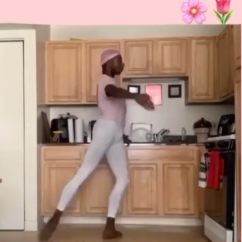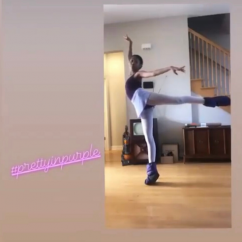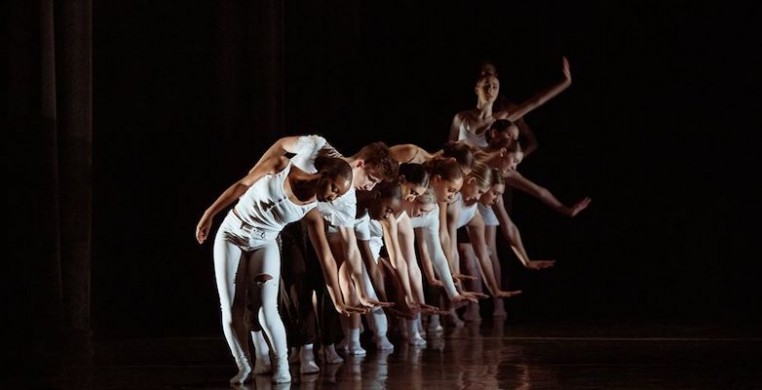We are over five months into “shut down” due to the COVID-19 outbreak, precariously perched between Phase 3 and Phase 4 of re-opening. It was just announced that Chicago Public Schools will be fully remote for the start of the school year on Sept. 8 through the first quarter. The country is in full tilt mode where news alerts generate more questions than definitive answers. But there is a silver lining in all this pandemic uncertainty: the dance community has shifted, adjusted and gotten creative to keep things moving. Over the month of August, we will be looking at four dance institutions to find out where they are in the reopening process and how they are coping with the new guidelines to make sure they are still bringing dance performance and education to the Chicago area.
 Academy dance student Dyani G. finishing up a virtual ballet class with faculty member Natalie Rast.
First up, the Chicago Academy for the Arts.
Academy dance student Dyani G. finishing up a virtual ballet class with faculty member Natalie Rast.
First up, the Chicago Academy for the Arts.
The high school closed for in-class learning in late March as soon as Governor Pritzker and Mayor Lightfoot announced the mandate. The Academy offers co-curricular programming with college prep courses paired with professional-level training in a number of arts tracks: dance, media arts, music, musical theater, theater and visual arts. The mission statement on their website states they teach “the skills necessary for academic success, critical thought and creative expression.” It’s the creative expression component that is most challenging to achieve with social distancing and remote learning.
The fall semester starts on Aug. 21 and it is no surprise that the classrooms will look a little different. Current plans include a hybrid model of online learning for academics and face-to-face, in-person learning for the arts with visual arts and dance classes held on separate floors. Randy Duncan, chair of the dance program, has been on faculty at The Academy for 24 years. “We will follow state and local guidelines including masks and social distancing, limit the number of students in the studio at the same time and alternate who is in the studio or online,” said Duncan on a phone call late last month. “We have ballet every day and jazz and modern on certain days. Every student will have a chance to be in the classroom (studio) at some point, but not all at the same time. To be honest, we’re still figuring it out.”
 Dancers attended class in their living rooms and kitchens during the spring semester, like student Isaiah D., shown here using the kitchen counter as a ballet barre.
A rescaling of the curriculum is also in order. For example, in the studio, there will be no partnering in ballet classes and no contact improv in modern/contemporary classes. Online teaching and learning present other issues. Most arts organizations around the country are now Zooming (that’s a verb now, right?) for everything. It’s one thing to hold a meeting. It’s quite another to teach a class which traditionally has you moving around each other physically. Duncan uses a laptop or his phone. “A senior dancer demonstrates for me and I can single out a dancer on my screen and give them personal corrections so they can hear what I’m wanting from them.” While not ideal, this is the new world artists are living in and dancers, in particular, have the advantage of being extremely adaptable to new environments.
Dancers attended class in their living rooms and kitchens during the spring semester, like student Isaiah D., shown here using the kitchen counter as a ballet barre.
A rescaling of the curriculum is also in order. For example, in the studio, there will be no partnering in ballet classes and no contact improv in modern/contemporary classes. Online teaching and learning present other issues. Most arts organizations around the country are now Zooming (that’s a verb now, right?) for everything. It’s one thing to hold a meeting. It’s quite another to teach a class which traditionally has you moving around each other physically. Duncan uses a laptop or his phone. “A senior dancer demonstrates for me and I can single out a dancer on my screen and give them personal corrections so they can hear what I’m wanting from them.” While not ideal, this is the new world artists are living in and dancers, in particular, have the advantage of being extremely adaptable to new environments.
For the upcoming semester, Duncan said they will adjust the hybrid model as necessary and reassess in the new year. “At first, we will focus on conditioning classes to ease them back in. They will need time the first few weeks to get back in shape. They want to come back. They want a space they can feel free to move around and we will provide that for them as best we can.”
The Academy has 35 dance students enrolled for this school year, seven of which are seniors. That creates additional challenges. Traditionally, seniors on the dance track present a senior class choreography project at the end of the school year on stage at the Athenaeum Theatre. The experience of producing a live theater performance with an audience from the ground up is immeasurable for a dancer stepping out into the professional world. Will it be safe to have a live performance? How many people can they have in the audience? Will it need to be filmed and streamed online? Those answers are yet to be determined but weigh on the minds of students, faculty and administration. The 2020 senior showcase was cancelled due to the coronavirus.
 Students stayed positive by posting pictures on Instagram and tagging the Academy's social media outlets. Dancer Eden M. is seen here showing off a purple leotard and booties.
Then there is the question of graduation. In 2020, The Academy moved the graduation ceremony online. “While not ideal, we did manage to pull off a fantastic graduation,” Duncan said. “We also moved the senior luncheon online. We did something quite special for them.” And principal Jason Patera hand-delivered diplomas to each of the school’s 30 graduating seniors in individual, socially-distanced mini-ceremonies with their families.
Students stayed positive by posting pictures on Instagram and tagging the Academy's social media outlets. Dancer Eden M. is seen here showing off a purple leotard and booties.
Then there is the question of graduation. In 2020, The Academy moved the graduation ceremony online. “While not ideal, we did manage to pull off a fantastic graduation,” Duncan said. “We also moved the senior luncheon online. We did something quite special for them.” And principal Jason Patera hand-delivered diplomas to each of the school’s 30 graduating seniors in individual, socially-distanced mini-ceremonies with their families.
Amid all of this uncertainty, is there a silver lining? For Duncan, the answer is simple. “We always try to keep everything positive. There is enough negativity already with the virus. We let the students know we are here for them and that we will get back to normalcy at some point.” Until then, they’re gonna Zoom!


